Turtles are an interestingly diverse group of reptiles. Known for the hard shells that they need to survive, turtles naturally occur in various states in the United States. The US is home to over 100 turtle species, some of which are native to Indiana. Several Indiana turtle species are terrestrial, while others are aquatic.
So, how many turtle species are in Indiana?
Indiana is home to 18 native turtle species, namely:
- Blanding’s Turtle
- Eastern Mud
- Eastern Box
- Eastern Spiny Softshell
- Midland Smooth Softshell
- Midland Painted
- Alligator Snapping
- Common Snapping
- Mississippi Map
- Common Musk
- Common Map
- False Map
- Ouachita Map
- Ornate Box
- Hieroglyphic River Cooter
- Spotted Turtle
- Western Painted
- Red Eared Slider
These turtle species have diverse appearances, eating habits, habitats, among other features. Only the subspecies have a majority of similarities; they mainly differ in terms of appearance only. Now let’s have a detailed look at these 18 turtle species native to Indiana.
1. Blanding’s Turtle
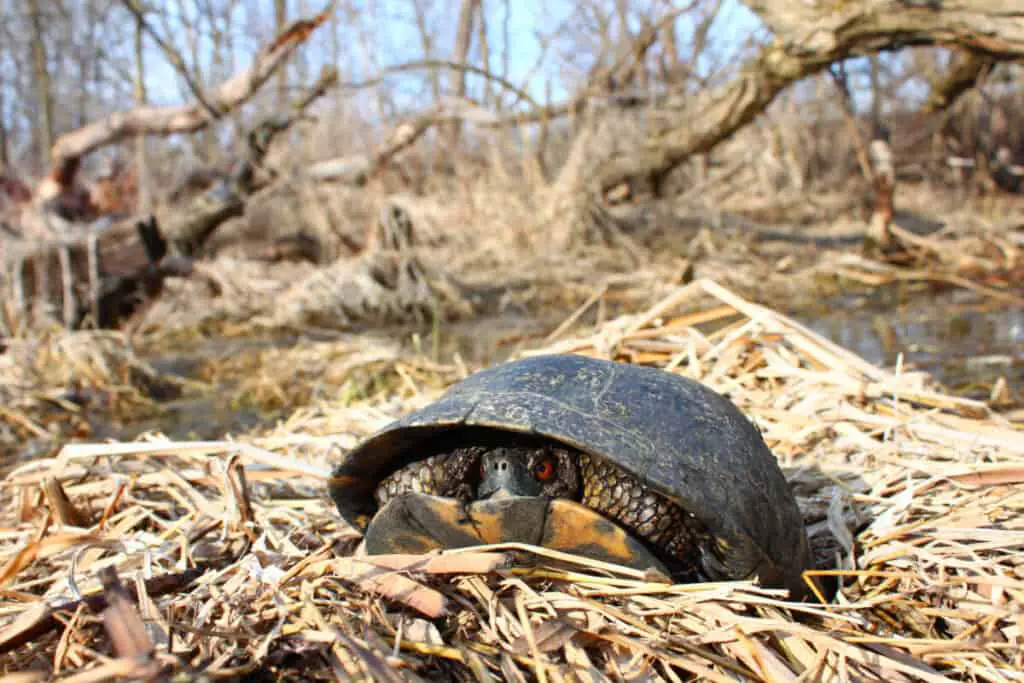
With the scientific name Emydoidea blandigii, this turtle has a more dome-shaped shell than most other turtle species. Its carapace, the upper part of the shell, is keeled and has a dark brown or black color.
Its plastron, the lower part of the shell, is yellow with some dark patterns. The plastron in males is slightly concave while it is flat in females. Their chins are yellow, while the head is flat at the top. The turtle has a long bright yellow neck.
Blanding’s turtle species hardly grows big, only getting to 6.5 – 8 inches long. Both males and females of this species grow to a relatively equal size. Their lifespan is an average of 70 years.
This species is omnivorous, meaning that their diet comprises both plant matter and meat. They mainly feed on insects, fish, snails, fruits, and aquatic vegetation.
The turtle has a variety of habitats but is fond of clear; still, shallow waters, having lots of aquatic vegetation cover. They also need open sandy upland habitats with grass or shrub cover for nesting season. These turtles are quite mobile and can cover large areas, meaning they can be found on roadsides, gardens, or farm fields.
They reach reproductive maturity at 14 – 20 years and nest between May and July. Their clutches carry an average of 14 eggs. Hatching takes from 50 to 75 days, and hatchlings start emerging in late August.
Blanding’s turtles are an endangered species in Indiana.
2. Eastern Box Turtle
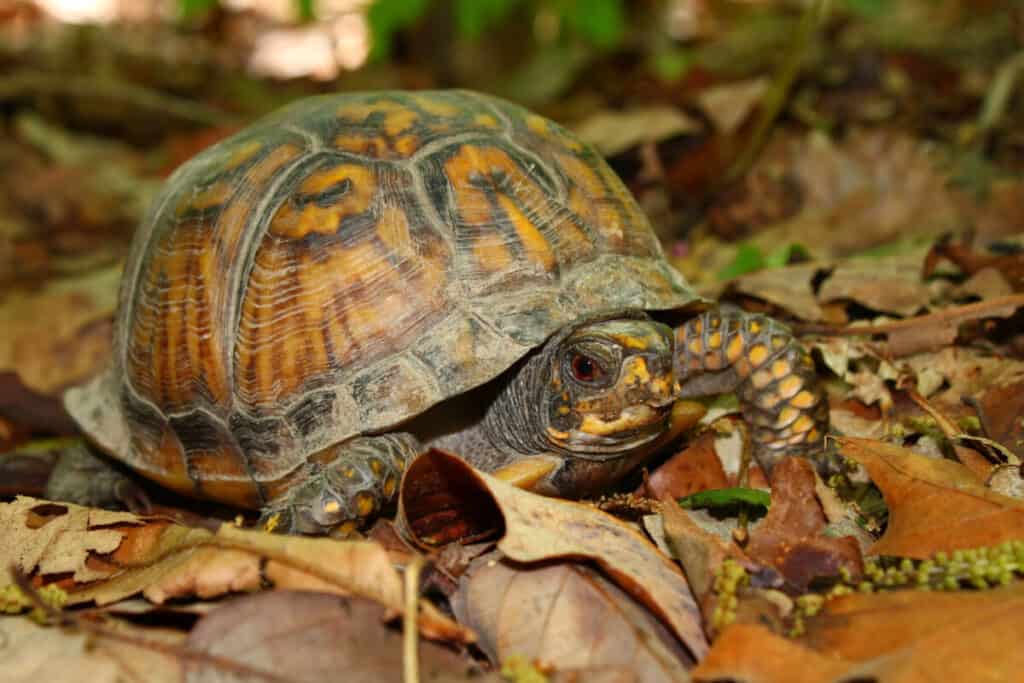
This turtle is one of the two box turtle species in Indiana. The scientific name of this turtle is Terrapene carolina carolina. Their shell is similar to that of a tortoise in that it has a high dome shape. It is brown or black and has varying patterns of yellow or orange.
The species’ legs, head, and neck are colored brown, with yellow-orange markings just like the shell. Males have a more concave plastron compared to females. Another distinguishing feature is that the eyes are red in males and brown in females.
These turtles are terrestrial but are also categorized as pond turtles. They live close to streams and ponds, which allows quick water access. Often, they inhabit meadows, grasslands in addition to pastures.
Eastern box species feed on an omnivores’ diet and eat pretty much everything they come across, from insects to vegetables, fruits, and vegetation. They grow to medium size of a carapace length of 4-7 inches. Their average lifespan is about 40 years in the wild.
Nesting starts from May through July, and Eastern box turtles lay a maximum of 8 eggs in a year. Their hatchling’s sex is temperature-based. They start emerging after 70-80 days of incubation. These box turtles make a good choice for a beginner pet turtle owner, but they are not cheap as they cost an average of $310.
Eastern box turtles are vulnerable species in Indiana. Their population has been reducing because of the destruction of their habitats.
3. Eastern Mud Turtle
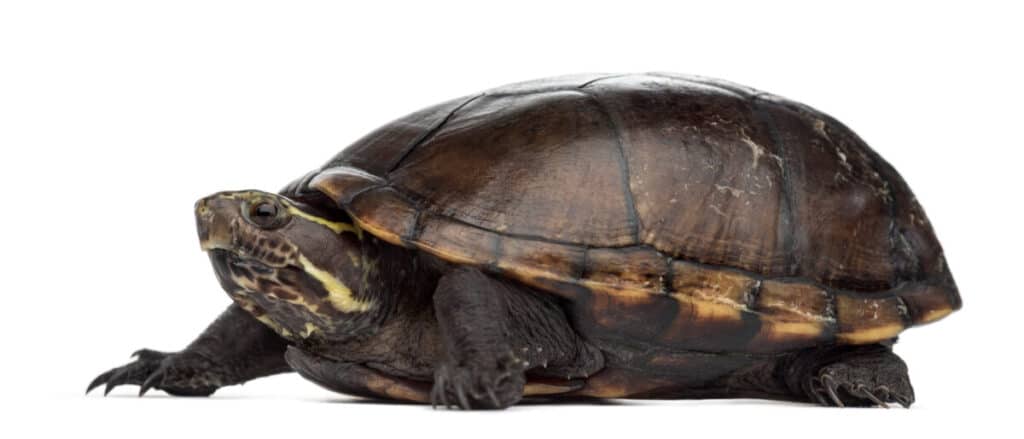
This turtle species goes by the scientific name Kinosternon subrubrum subrubrum.
An eastern mud turtle has a plain appearance with no markings, blobs, or even spots on the carapace, whose color ranges between dark yellow and black. The plastron is also plain but is at times lighter than the carapace. It has white to yellow stripes on its head, which can be used as an identification feature.
Eastern mud turtles have an average lifespan of 40 years in the wild but can live longer under favorable conditions. They rarely grow big, only getting to 5-7 inches long.
These turtles are aquatic, and their name mud turtles come from their preference to live in soft bottoms with either mud or sand. Therefore, Eastern mud turtles are common in rivers, lakes, swamps, and marshes. They are good bottom crawlers but poor swimmers.
Mud turtles feed on an omnivore’s diet that often includes fish, snails, insects, and a variety of vegetation.
Nesting season from May to July, and the females lay an average of 4 eggs and a maximum of 6 of in either sandy loam soils in dead vegetation matter. The eggs remain in incubation for an average of 105 days when hatchlings emerge, measuring a maximum of 1.1 inches. At times, hatchlings opt to overwinter in the nests.
Eastern mud turtles are species of least concern in Indiana.
4. Eastern Spiny Softshell Turtle
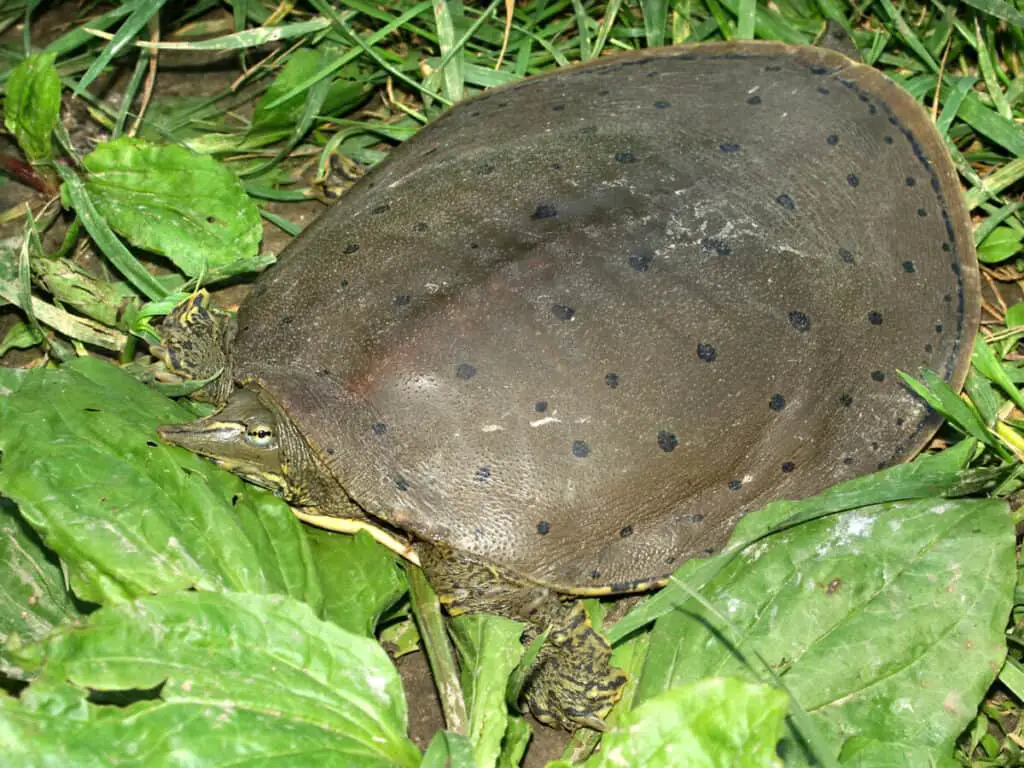
This turtle has the Latin or rather scientific name Apalone spinifera spinifera. When loosely translated, the term spinifera means to bear thorns which refers to the spine-resembling tubercles on the front margin of their carapace.
It is a freshwater species with olive to brown, flat carapace with patterns of either thin lines, black circles, or black blobs. The patterns are more visible in hatchlings than in adults.
A distinguishing feature of the spiny softshell turtle is its flat, leathery shell and long snout. They also have a big black eye-like spot and can live up to 50 years.
Female eastern spiny softshell turtles grow significantly bigger than the males getting to a carapace length of between 7 and 17 inches. On the other hand, males grow to between 5 and 9 inches.
They are aquatic and hardly leave the water. These turtles are common in rivers and their tributaries but may also be found in ponds. This turtle species has a preference for habitats with basking spots and sandbars.
Eastern spiny softshell feed on a carnivorous diet right from when they are hatchlings and even after maturity. Their main meals include fish, crayfish, and aquatic larvae. They have a strong visual sense that enables them to see their prey from far.
In terms of reproduction, they nest between March and May. The females lay an average of 22 eggs on either loose soil or sandbars. The eggs remain in incubation for up to 80 years and emerge between August and September.
The Eastern spiny softshell turtle species are of least concern in Indiana.
5. Midland Smooth Softshell Turtle
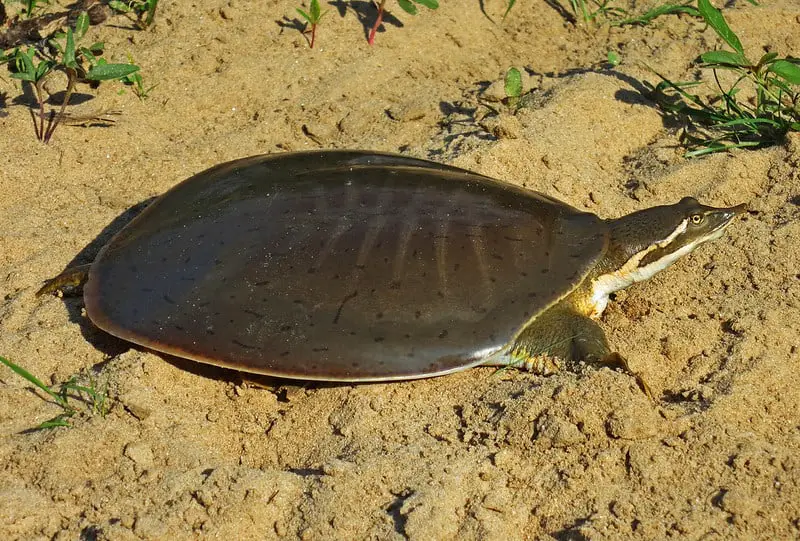
The biological name of this turtle species is Apalone mutica mutica. They almost look like the spiny softshell species but lack the bumps or spins on the front margin of their carapace. Otherwise, the two species share habitat preferences and reproduction characteristics.
Midland smooth softshell turtle has a plain-looking shell. The color of their shells varies depending on sex and age. Grown females have a speckled carapace with blotches of brown, gray, or olive. The carapace in juveniles and males is brown or olive-gray with dull markings of dashes and dots. Their plastron is cream in all of them.
Their legs and heads are gray or olive on the upper part and cream on the lower part. Behind their eyes is a light-colored stripe that is bordered by black. They use their long necks to catch passing prey as they lay still hiding in the substrate.
Because of their soft shells, they defend themselves with their sharp, strong clays. Mature Midland smooth softshell males measure 4 – 7 inches in length, while females have a carapace length of 6 – 14 inches.
They are aquatic, often inhabiting streams and rivers. These turtles can also be found in still waters such as lakes and ponds, preferably with muddy or sandy substrates, often avoiding rocky floors.
Like the spiny softshell, Midland smooth softshell turtles are carnivorous but may consume some plant matter.
Breeding occurs from April to June, followed by nesting on sandbars with minimal vegetation. A clutch can carry between 1 and 33 eggs. Midland softshell turtles may lay up to 3 clutches in a year.
They are turtles of least concern in Indiana.
6. Midland Painted Turtle
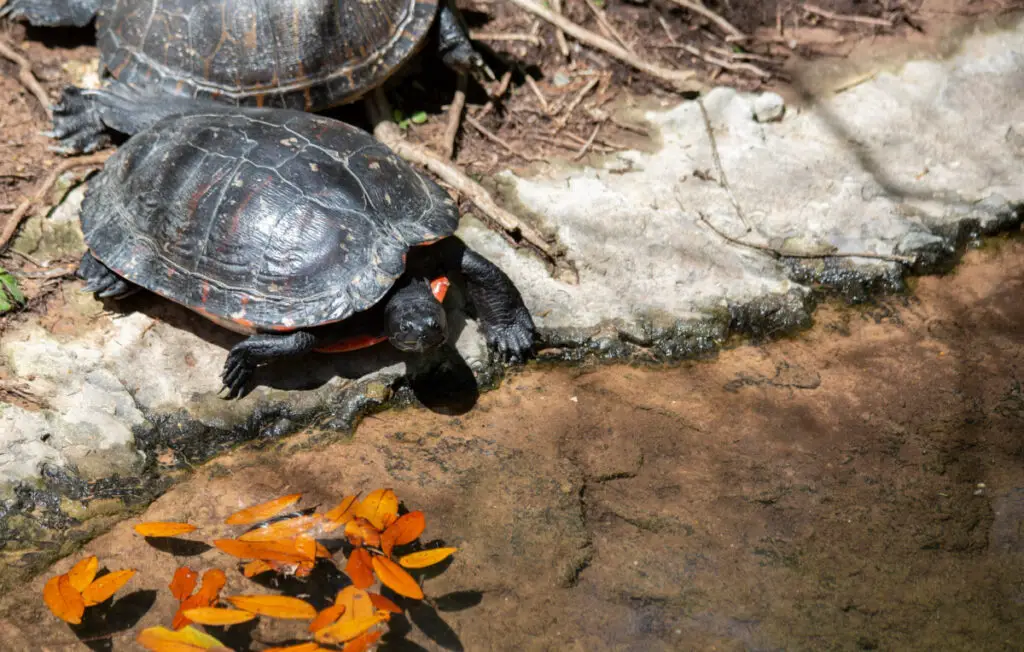
These turtles are biologically known as Chrysemys picta marginal. Their carapace is broad, slightly domed, and smoother than in most other turtle species. The carapace ranges from olive to black and has a faint orange or red pattern. Its plastron is dark tan or yellow with dark markings at the midline.
A distinct feature of Midland painted turtles is a horizontal yellow line in the eyes that traverses their pupil. Their heads have yellow stripes all over the nose, face, and mouth.
They grow to a carapace length of 5-9 inches. These turtles have a lifespan of 30 to 40 years in the wild. Midland painted turtles are opportunistic feeders, often eating fish, frogs, and vegetation. Their favorite food is aquatic insects.
They inhabit waters bodies such as lakes, slow-flowing creeks, marshes, and ponds with plenty of aquatic vegetation and basking spots. The frequent shorelines, or rocks and logs in water to bask. During winter, they go into dormancy at the bottom of the water bodies.
Sexual maturity in females occurs when they are aged between 6 and 10, while maturity in almost all males occurs by the sixth year. These turtles nest in sandy, loamy soils with access to the sun. Their clutches carry up to 14 eggs each, and they take around 80 days to hatch. Hatchlings may emerge towards the end of fall or overwinter inside the nests.
This species is classified as of least concern in Indiana.
7. Alligator Snapping Turtle
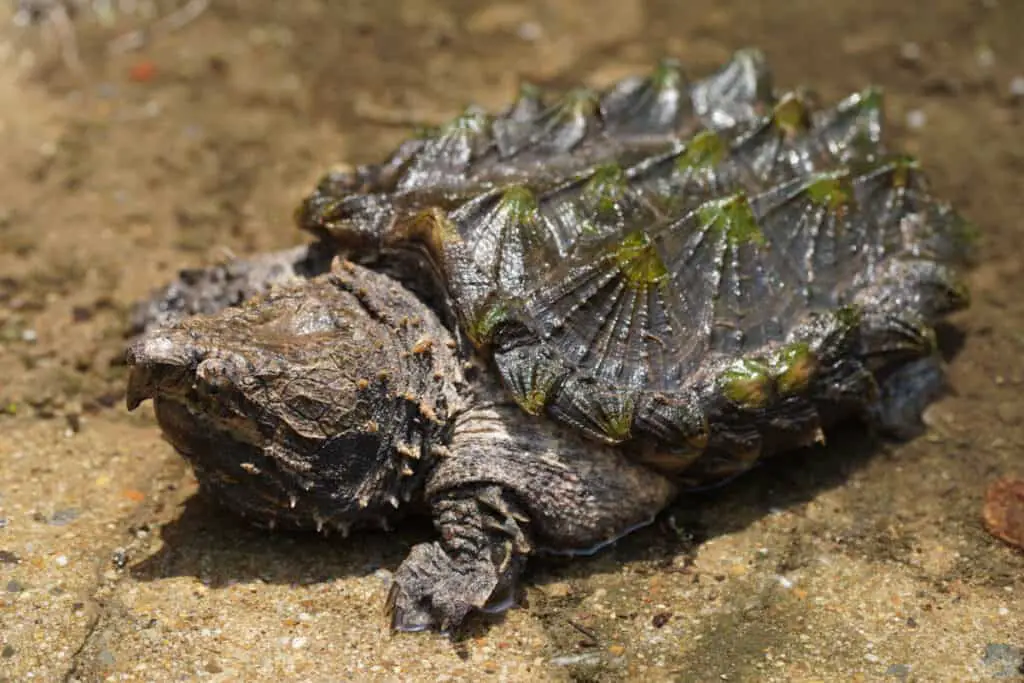
Macrochelys temminckii is the scientific name of this turtle species. Another term used to refer to these turtles is loggerhead snappers. They are one of the biggest freshwater turtles globally, attaining up to 26 inches in carapace length.
Their main distinguishing feature besides size is that their upper shell has very strong ridged spikes. Their skin is dark brown and has spines resembling saws in their tails.
This turtle species is carnivorous and mainly feeds in insects, tiny turtles and other reptiles, amphibians, and fish. They trick their prey using a movable tendril that plays the role of bait. Their strong jaw can crash any prey.
As aquatic turtles, their habitat is in deep water bodies such as rivers and lakes. This species is almost exclusively aquatic, hardly coming to land other than to lay eggs.
Alligator snapping turtles tend to stay submerged in water with no movement to the extent that algae grow on their shells. They can remain so for about 50 minutes before coming up to the water surface for air.
They have a pretty long lifespan of between 60 and 70 years.
Nesting occurs between May and July. The eggs remain in incubation for an average of 85 days with a 15 days before or after allowance.
They are vulnerable species in Indiana. Their main threats are over-harvesting and degradation of their habitats.
8. Common Snapping Turtle
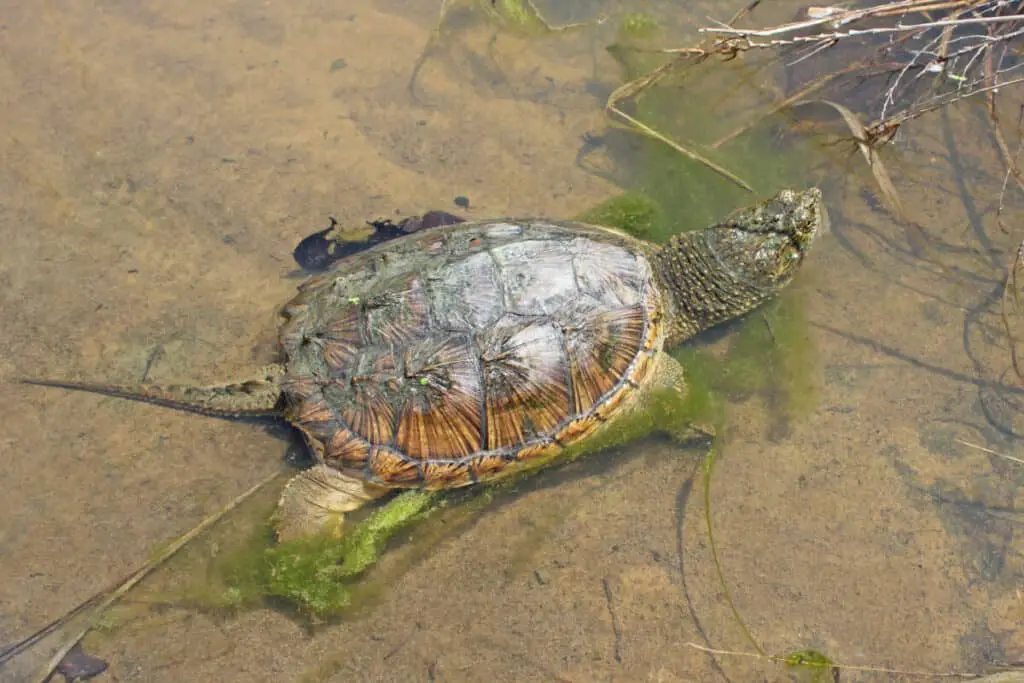
It is one of the largest freshwater turtles. They have a dark-colored upper shell ranging from brown to green to black whose edges are serrated at the back. The lower shell is smaller and doesn’t fully cover the entire flesh. Juveniles have three ridges which become less visible as they mature.
Common snapping species have a long tail which is often longer than their upper shell. They also have a big head and a sharp hooked hard beak-like jaw. These turtles use it for tearing food and attacking predators.
When mature, these turtles measure an average length of between 8 – 12 inches and weigh up to 35 lbs. Their Latin name is Chelydra serpentine.
They are primarily aquatic and often inhabit slow-flowing waters with muddy or sandy bottoms. They are common in rivers, pools, lakes, bogs, creeks, swamps, marshes. These snapping turtles can also live in brackish waters.
These snapping turtles feed on an omnivore diet and eat insects, crayfish, spiders, birds, frogs, small animals, and plants. Meat comprises two-thirds of their diet. When young, they forage for food but lay motionless in water and ambush prey using their powerful jaw when older.
They can mate and reproduce once their upper shell length reaches 8 inches. The females leave water searching for suitable nesting areas such as lawns, muskrat burrows, banks, and gardens. They lay up to 40 eggs in a clutch, most of which are predated by skunks, raccoons, and crows, among other predators.
Some common snapping turtles are killed on the road while looking for nests or coming from nesting. However, they are considered as of least concern in Indiana.
9. Mississippi Map Turtle
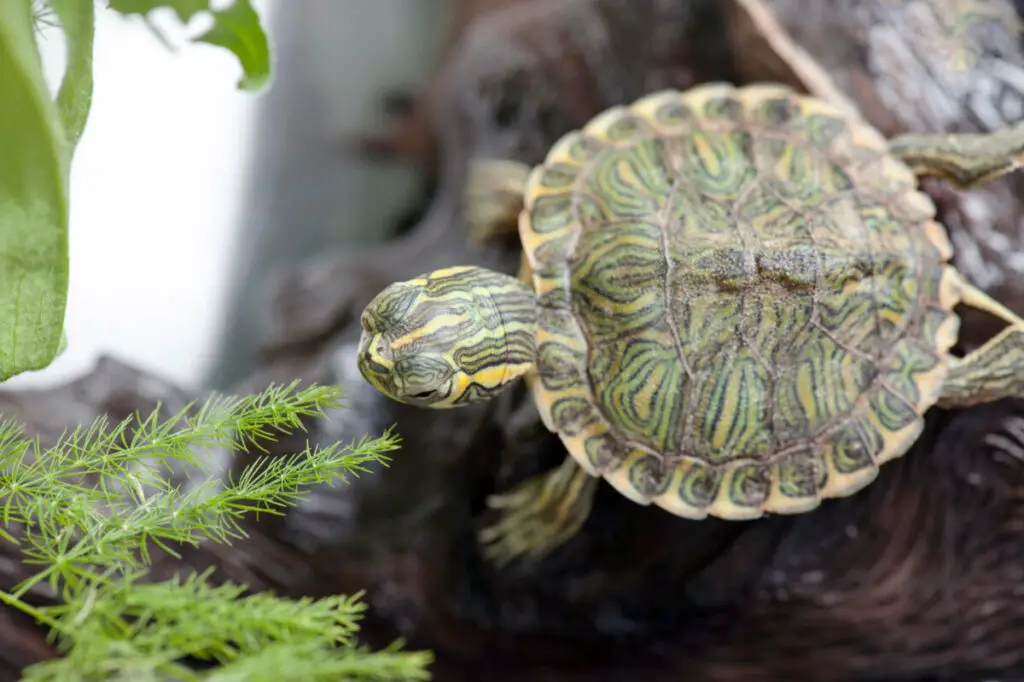
These turtle species get their name from the Mississippi river basin. They are sometimes referred to as Sawback turtles because of the diagonal line running down the upper shell and have the scientific name Graptemys pseudogeographica kohni.
Mississippi map turtles are some of the common pet turtle species often preferred for their beautiful appearance. Their body color varies from olive green to brown or dark brown. The shells and skin have map-like contours, and at times, the carapace has patterns.
They have a lifespan of 15-25 years which is relatively shorter compared to other turtles. Males grow to a carapace length of 3.5-5 inches while females are significantly bigger, getting to 6-10 inches.
Mississippi map turtles are aquatic and hardly leave the water other than to lay eggs. They feed on an omnivore’s diet and generally eat almost everything they come across, including dead fish, aquatic insects, mollusks, and aquatic vegetation.
When it comes to reproduction, male Mississippi map turtles reach maturity at 4-6 inches or 3-5 inches long while females take longer, reaching maturity at 8-14 years or 6-10 inches long. Females lay up to three clutches in a year, each carrying between 5 and 22 eggs.
They are of least concern in Indiana.
10. Common Musk Turtle
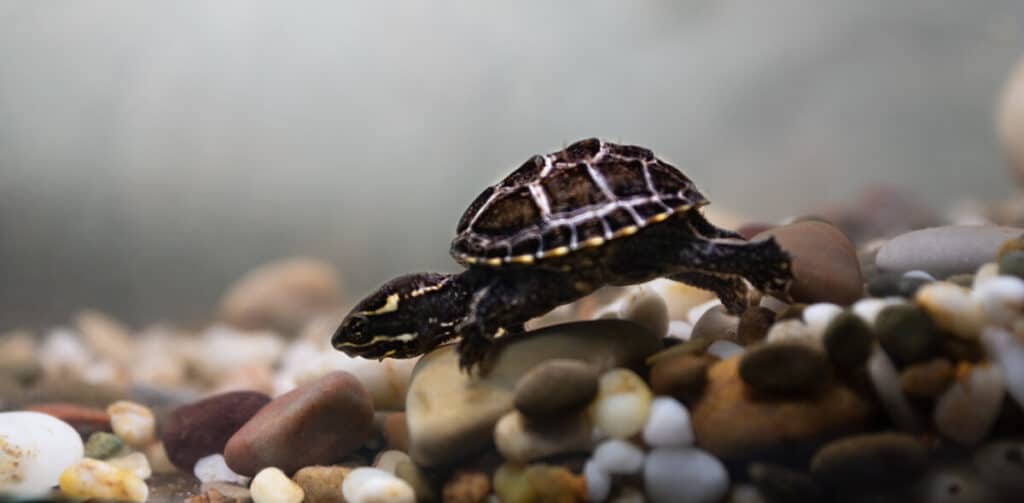
Commonly known as “stinkpots,” their scientific name is Sternotherus odoratus. The nickname stems from a strong odor they produce when they are threatened. They are pretty small turtles measuring between 2 and 5 inches. They have a black or brown carapace.
One of the identifying features of these turtles is two distinct stripes found on the chin and throat. The plastron is dark or brown with prominent scutes. The turtle’s feet are webbed, which means that they are good swimmers. Also, the males have thicker and slightly longer tails than females.
Common musk turtles are commonly found in shallow, slow-flowing water bodies with soft floors and dense vegetation. Musk turtles are nocturnal and can be seen foraging near river banks. Their diet comprises both meat and plants. They commonly feed on insects, seeds, snails, tadpoles, algae, and aquatic vegetation.
Breeding in musk turtles starts in May and ends in September. A female turtle will lay up to two clutches each year, each clutch holding between 1 and 9 eggs. Incubation in musk turtles takes between 70 and 90 days.
Hatchlings start emerging by late August or early September. Females reach sexual maturity by the fourth year of life, while males take two years. These musk turtles have a relatively long lifespan at 55 years.
In matters of conservation, common musk turtles are listed as endangered species in Indiana.
11. Common Map Turtle
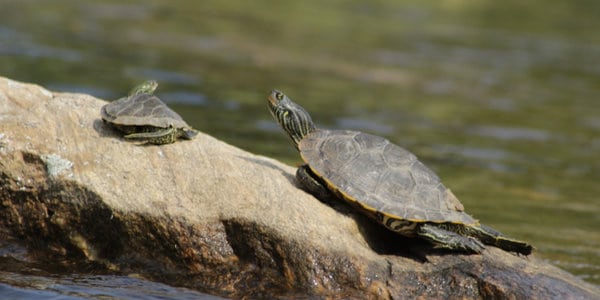
They are also known as Northern map turtles, and their scientific name is Graptemys geographica. Of all the map turtle species, Common map turtles are the most abundant. Mature female turtles measure 10.5 inches when fully grown, while males measure up to 6.5 inches long.
The carapace of common map turtles is olive green with an intricate system of thin yellow stripes. These faint lines resemble a topographical map. The skin ranges from olive green to brown with yellowish-green markings. The turtle’s lifespan is about 25 years.
Common map turtles are common in clear, slow-flowing water bodies with soft and loose floors. They can be found in rivers, lakes, craters, large streams, and other aquatic areas with ample basking space.
These turtles are omnivores but lean heavily towards meat that vegetation. Their diet consists of snails, mussels, insects, crayfish, mollusks, and other small aquatic animals. They will occasionally feed on vegetation.
The nesting period is between May and July. Female turtles will lay between 6 and 20 eggs in a clutch. Incubation starts almost immediately and lasts between 50 and 70 days, with hatchlings emerging in late August or early September.
If hatching delays, it is common for hatchlings to overwinter in the nest. Sexual maturity occurs by the 15th year for female turtles, but it happens sooner for males.
While map turtles are classified as of least concern, their population is steadily decreasing. The primary reasons for this are increased predation and habitat destruction for both the turtles and their prey.
12. False Map Turtle
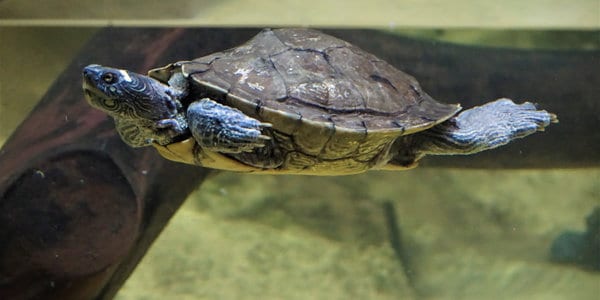
The scientific name for this turtle is Graptemys pseudogeographica. They are mid-sized turtles whose carapace has a length of between 3 to 10 inches. The carapace is olive or brown with thin interconnected yellow stripes.
Their plastron is greenish-yellow and has many brown lines along the scute seams. Likewise, the skin, neck, and head have a greenish color with many yellow lines. False map turtles have a distinctive thick yellow reverse L-shaped line behind each eye.
A mature map turtle measures up to 12 inches in females and 6 inches in males and may live 50 years.
False map turtles are omnivores and primarily feed on mollusks, crustaceans, earthworms, fish, and aquatic insects. These turtles are mainly found in lakes, river sloughs, bogs, or rocks. They will quickly slide into the river at the slightest provocation.
False map turtles breed from May through September. Female map turtles will mate and lay eggs between May and June. A clutch of false map turtle eggs contains between 6 and 13 eggs. They may lay more than clutch in a year.
Incubation takes between 60 and 90 days, where eggs hatch by mid-September. False map turtles may mate twice in the same year. Sexual maturity happens between ages 4 and 6 in males and ages 8 and 14 in females.
In Indiana, false map turtles are considered as of least concern in conservation terms. However, their population has declined as a result of the destruction of habitats and breeding grounds.
13. Ouachita Map Turtle
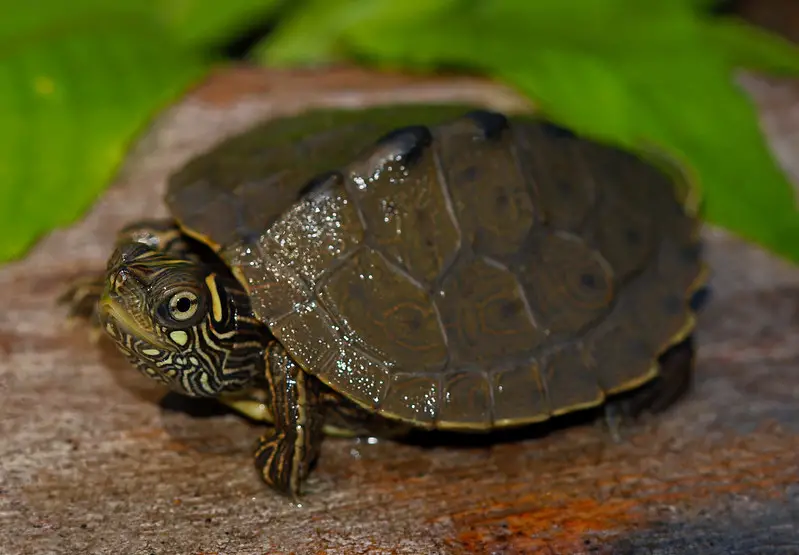
Scientifically, Graptemys ouachitensis ouachitensis, Ouachita map turtles are one of the three subspecies of the map turtle species. They are mid-sized semi-aquatic with a prominent vertebral keel on their carapace.
The carapace is brown or olive with yellow or gray stripes. It is also serrated on the rear edges. On the other hand, the plastron is plain yellow, while the head, limbs, and neck are covered with thin yellow stripes. Ouachita turtles have a deep yellow patch behind each eye.
A mature turtle has a length of between 6 and 10 inches.
These turtles are common in slow-moving waters like rivers, oxbows, sloughs, lakes, and reservoirs. Overwintering occurs deep under the silty floors of their habitats. They are omnivores and feed on insects, worms, dead fish, snails, aquatic plants, and other small aquatic animals.
Reproductively, Ouachita turtles will be active from March to October every year. Egg-laying starts in May and ends in early July. A female turtle may lay up to 3 clutches each year, with each clutch containing between 6 and 12 eggs.
Incubation takes 70 to 90 days for the eggs to hatch. Hatching happens in late August and early September. It takes about 14 years for the turtles to start reproducing.
In Indiana, Ouachita map turtles are not under any threat and have a reasonably stable population. They are under the list concern list in Indiana.
14. Ornate Box Turtle
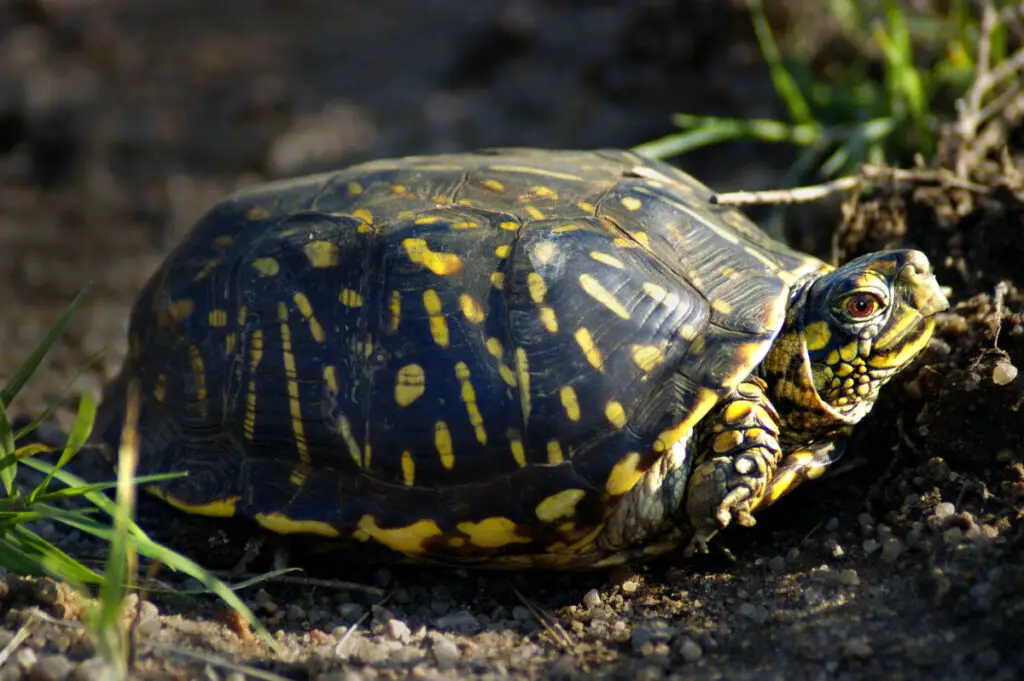
Ornate turtles, Terrapene ornate, have a high-domed carapace with a hinged plastron which enables them to retract to the shells when threatened by predators. The upper shell is brown, with yellow lines emerging from the center of each pyramid-like scute.
These turtles have dark gray skin and a dark brown head that has yellow markings. As they age, they develop a greenish color on their heads while their tongues become purple. A mature turtle can measure up to 6 inches long.
Ornate box turtles are known to live for between 50 and 100 years.
Being terrestrial, they are common in semi-desert grasslands and woodlands. The species prefers areas with a lot of vegetation cover and loose soil. They are omnivores whose principal source of food is worms, insects, and vegetation. They will forage in the morning or after it rains. Further, they take shelter in caves during the dry season.
Reproduction in Ornate box turtles starts at the age of 7 or 8. A female lays a clutch containing 2 or 3 eggs. It takes about 65-90 days for the eggs to hatch. A hatchling’s sex is influenced by temperatures—higher temperatures, above 80 degrees, favoring female turtles than male ones.
There hasn’t been much research on the ornate turtles in Indiana, but the little information available indicates that these turtles fall under the special concern category in terms of conservation.
15. Hieroglyphic River Cooter
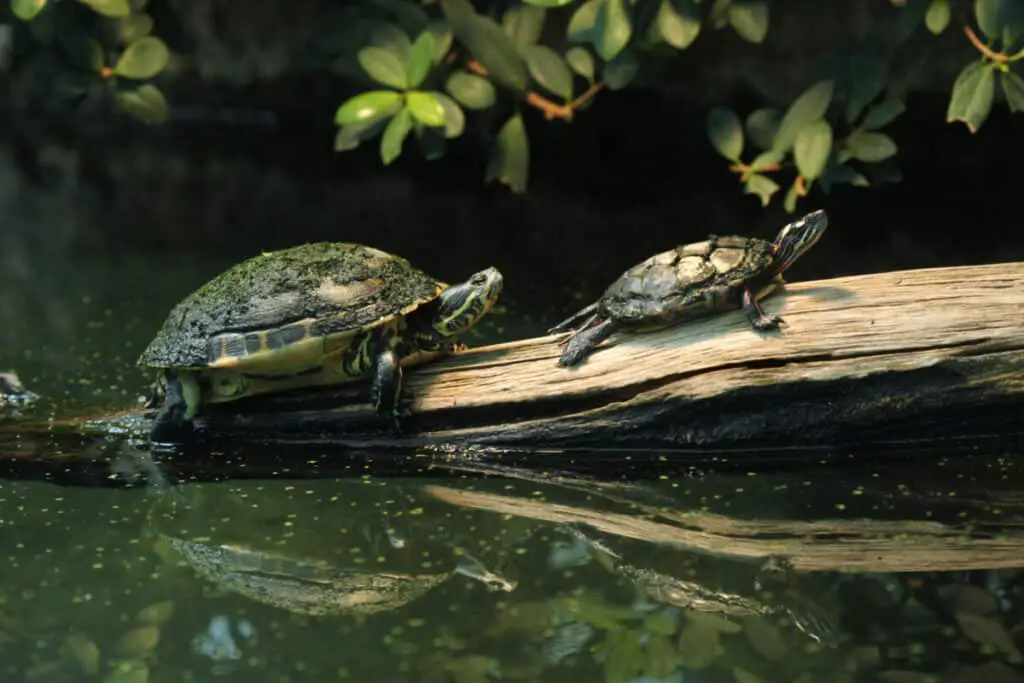
Scientifically, these turtles are known as Pseudemys concinna. They are native to the state of Indiana and very similar to Eastern river cooters. Their carapace is relatively flat, brown, or olive with numerous yellow or cream markings. They also have a vertebral keel that disappears with age. The plastron is yellow with a well-developed black pattern.
River cooters can be found in freshwaters or even brackish habitats. These include marshes, rivers, and ponds that are densely vegetated. They are fond of basking, and it is not uncommon to find cooter turtles basking in the company of sliders and painted turtles.
Cooters hibernate underwater, hidden in the vegetation found on floors of their aquatic habitat, be it streams or rivers. They are also excellent swimmers and can move at considerable speed in the water. These turtles are omnivores, and their diet comprises aquatic plants, insects, mollusks, crustaceans, and algae.
Reproduction in river cooters begins in March and ends in September. A female cooter will mate and lay eggs between March and June, hatching after 90-100 days. She may lay one or more clutches a year, each containing between 10 and 20 eggs. Hatchlings may overwinter before leaving the nest.
Hieroglyphic cooters are one of the endangered species in Indiana as a result of habitat destruction.
16. Spotted Turtle
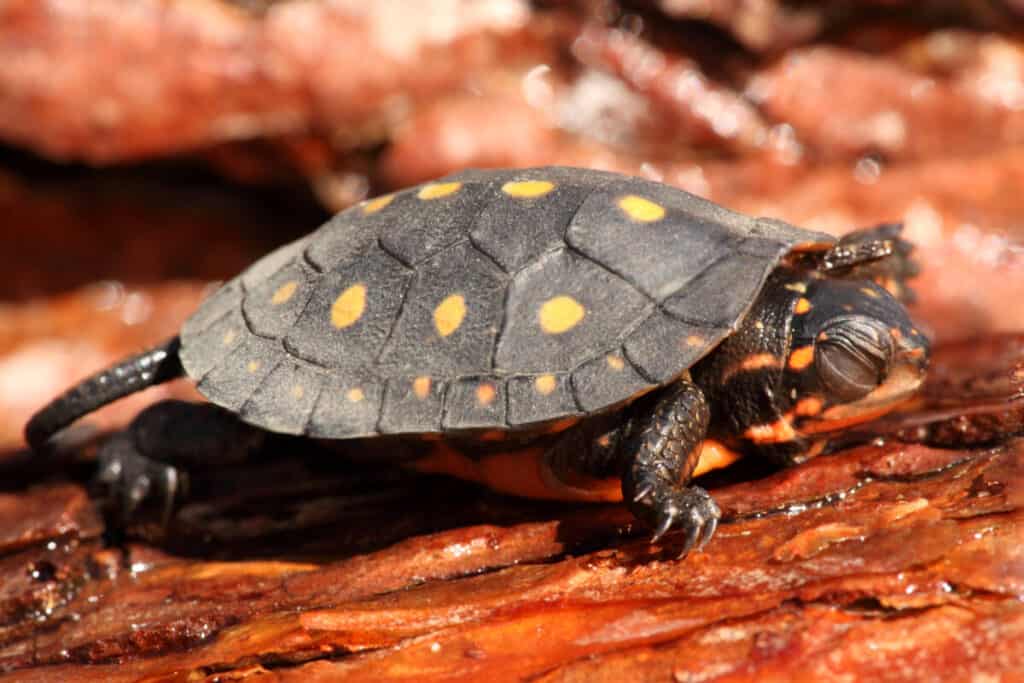
Scientifically, spotted turtles are called Clemmys guttata. In Indiana, they are found spread across the northern portion of Indiana’s wetlands. They are endangered species due to population decline resulting from habitat destruction to pave the way for urban construction.
As their name suggests, spotted turtles have a smooth gray or black carapace with many yellow spots that disappear with age. Their plastron is yellow with dark patches.
A distinctive feature of spotted turtles is two large yellow or orange patches on each side of its black head. The skin, legs, and tails are all black but with numerous yellow marks. When mature, they measure between 3 and 6 inches.
The lifespan of spotted turtles is about 50 years.
As with most turtles, spotted turtles are omnivores, with their diet mainly consisting of mollusks, crustaceans, seeds, fruits, soft aquatic plants, insect larvae, carrion, and amphibian eggs. Their main predators are raccoons and muskrats.
Their habitat includes shallow clean, and clear water bodies with soft floors and lots of aquatic vegetation. Since they also like basking, spotted turtles prefer rocky banks or those with lots of dead vegetation.
Spotted turtles mature sexually by the time they are 14 years. Reproduction starts in April and ends in September when the hatchlings emerge. A female turtle lays only one clutch each year with 1 to 8 eggs. Incubation takes between 45 and 85 days. The hatchling’s sex is majorly determined by temperature during incubation.
They are endangered species in Indiana.
17. Western Painted Turtle
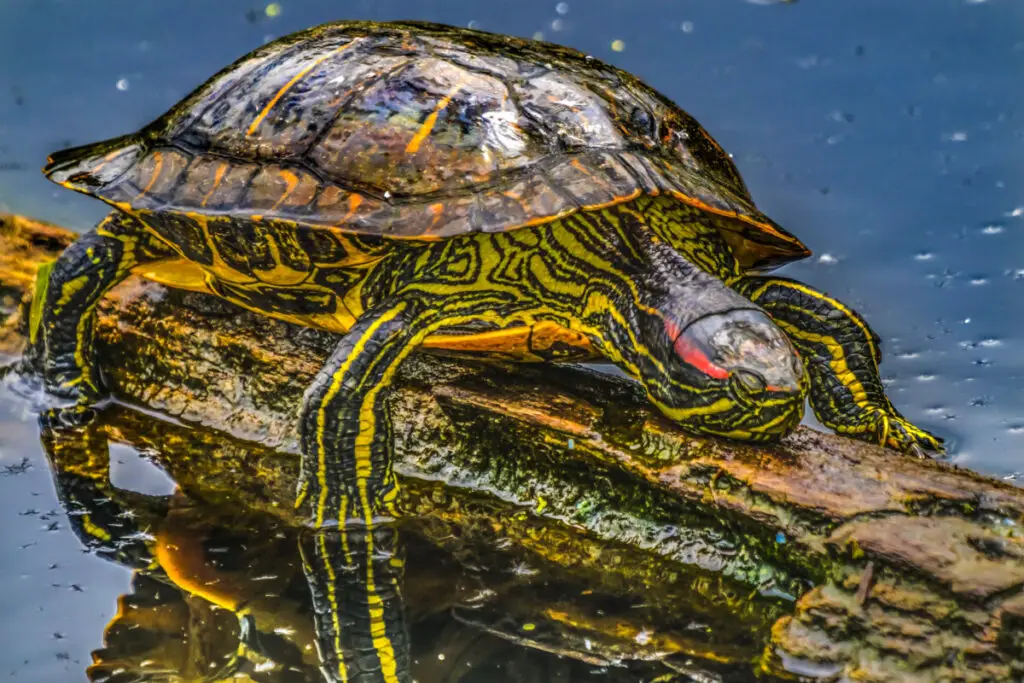
Western turtles, Chrysemys picta bellii, have a smooth, unkeeled carapace that is olive green or brown with an irregular and sometimes net-like pattern. Their skin is dark olive, occasionally black, with thin yellow stripes on the lower side of the neck, limbs, and tail. The plastron assumes a brown color.
A distinctive characteristic is two tooth-like protrusions found on its upper jaw.
Western painted turtles are the largest of all painted turtles achieving a length of up to 10 inches. They are known to have a long lifespan, some living up to 50 years.
Western painted turtles are common in slow-moving water bodies with soft floors and plenty of vegetation. They are fond of basking on rocks or floating vegetation. These turtles can be easily found in ponds or ditches. In addition, they move on land but not far from water sources.
Being omnivores, western painted turtles will feed on aquatic vegetation, mollusks, tadpoles, small fish, fruits and seeds, and other marine life.
Breeding in these turtles happens from March and ends in August or September when hatchlings emerge. A female turtle can hold sperms in her body awaiting fertilization. After fertilization, a female will lay between 1 and 23 eggs in a clutch. It takes about 70 to 90 days for the eggs to hatch. Reproductive maturity takes about 7-10 years.
Western painted turtles are of least concern in Indiana.
18. Red-eared Slider Turtle
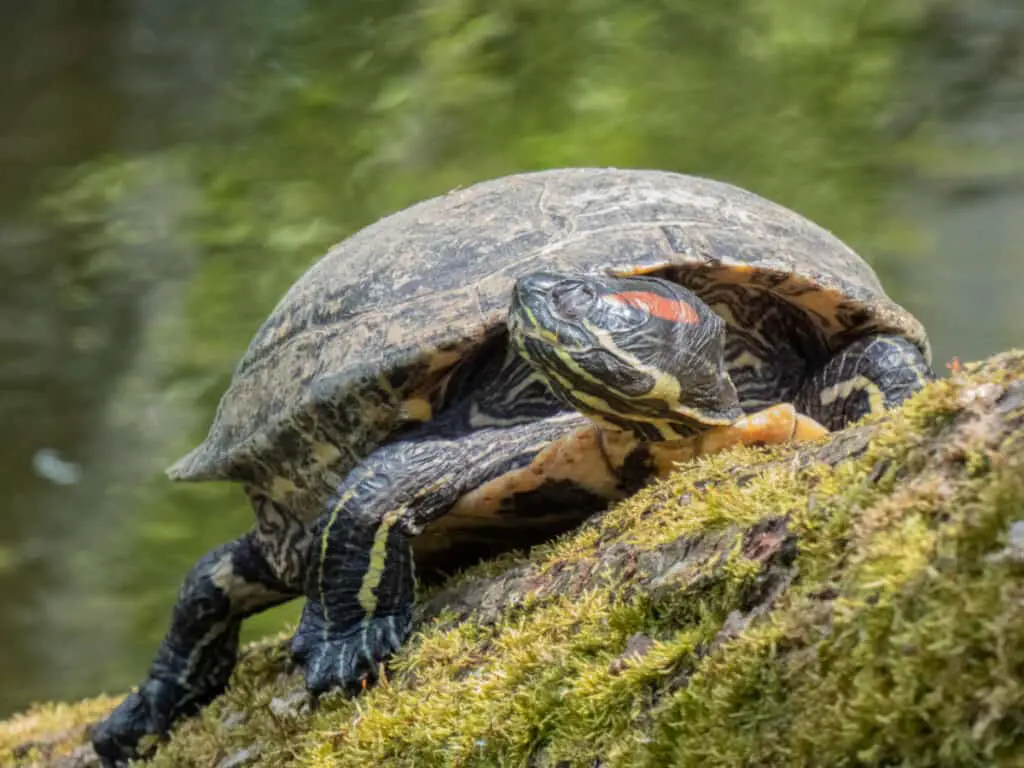
The Latin name of this turtle is Trachemys scripta elegans. It is a popular pet turtle and the only native slider turtle in Indiana.
As the name suggests, its most distinctive feature is a big bright red or sometimes orange stripe behind each eye. The carapace of red sliders is oval, with a green or green-brown color with light green or yellow markings. It is also serrated towards the margin.
Their plastron has a light yellow color and distinctive marks located in the middle. Red-eared sliders are green with irregular yellow stripes on their skin, neck, tail, and limbs. When mature, these turtles achieve a carapace length of 12 inches.
The lifespan of a red-eared slider is about 20 to 30 years.
Red-eared sliders are omnivores and feed on aquatic vegetation, tadpoles, invertebrates, and small fish. Juveniles feed entirely on meat. They are commonly found in shallow, slow-flowing waters with soft mud bottoms. Since they love basking, red sliders will prefer areas with rocky banks.
Sexual maturity in red-sliders occurs by the 5th year in females and the 3rd year in males. Breeding happens between April and May- a female turtle will lay between 2 and 24 eggs in a clutch. Hatching occurs after 70-100 days, with hatchlings emerging from late August and early September.
Red-eared sliders are species of least conservation status in Indiana.
Conclusion
From the above list, it is evident that Indiana has a good diversity of turtle life. Having such a large number of turtle species is an indication that natural factors favor turtle life in the state. Despite this, it is essential to institute measures to conserve endangered turtle species like the Blanding’s turtle.
One of the leading threats is human activities in turtle habitats, primarily real estate development. Encouraging conservation measures in the state will help ensure that the threatened turtles are not wiped out.
One of the most effective ways that turtle enthusiasts may help conserve turtles is by ensuring that turtle habitats are protected. Enlightening people on the dangers of human activities around turtle habitats will also assist in decreasing their mortality.